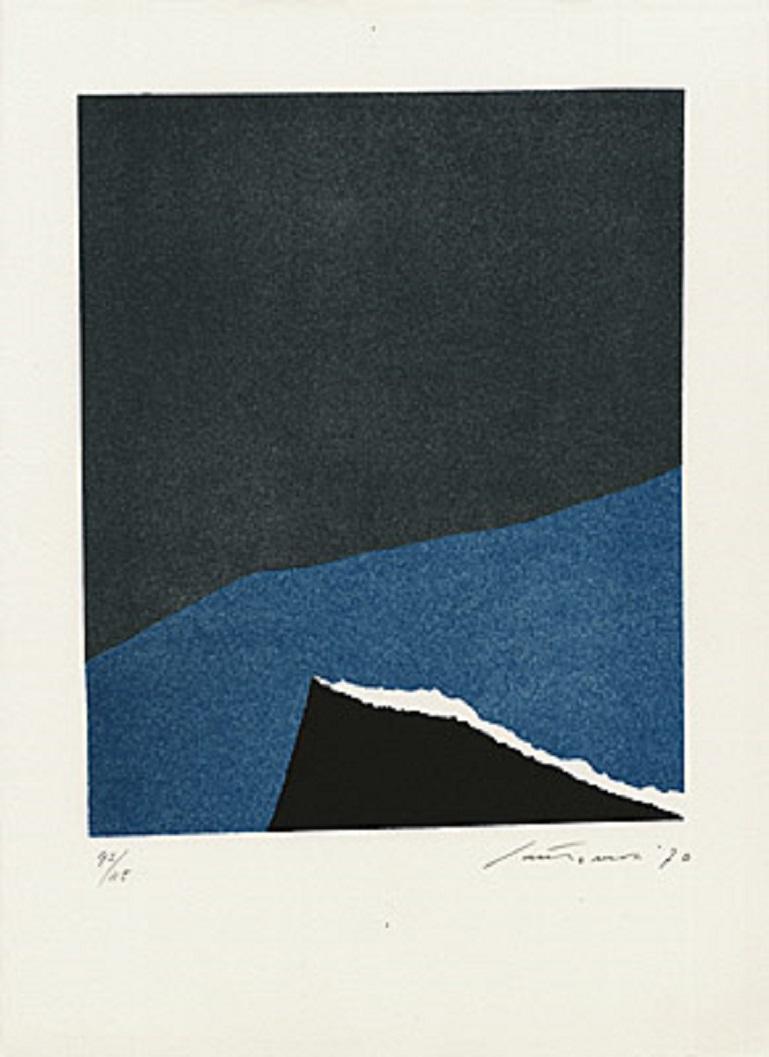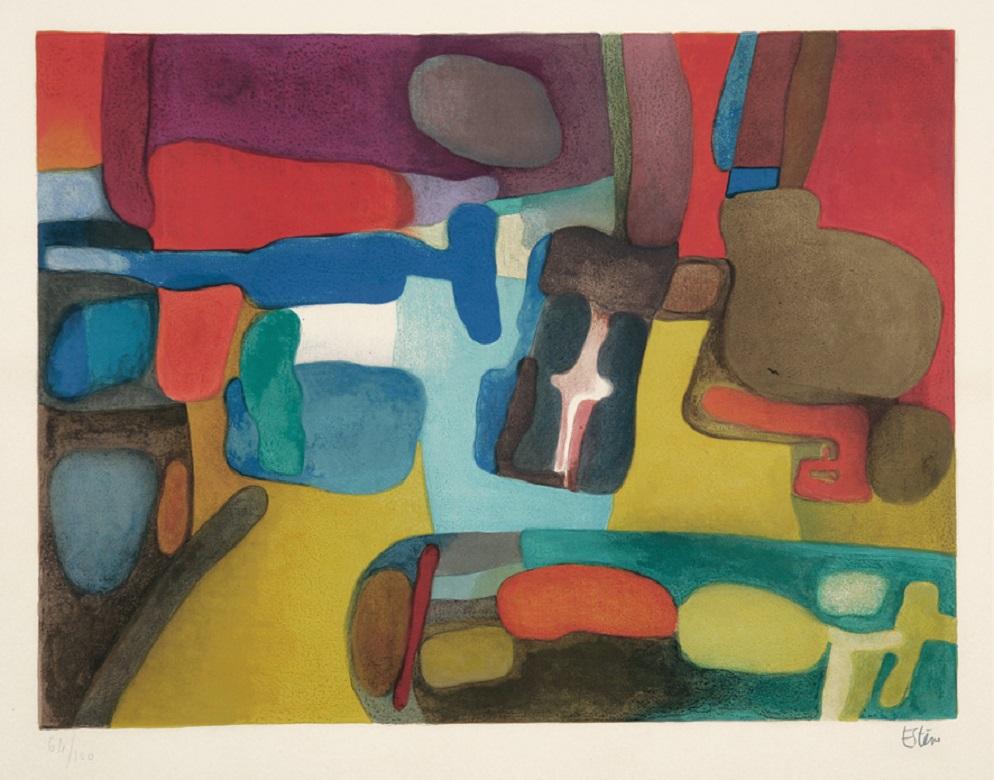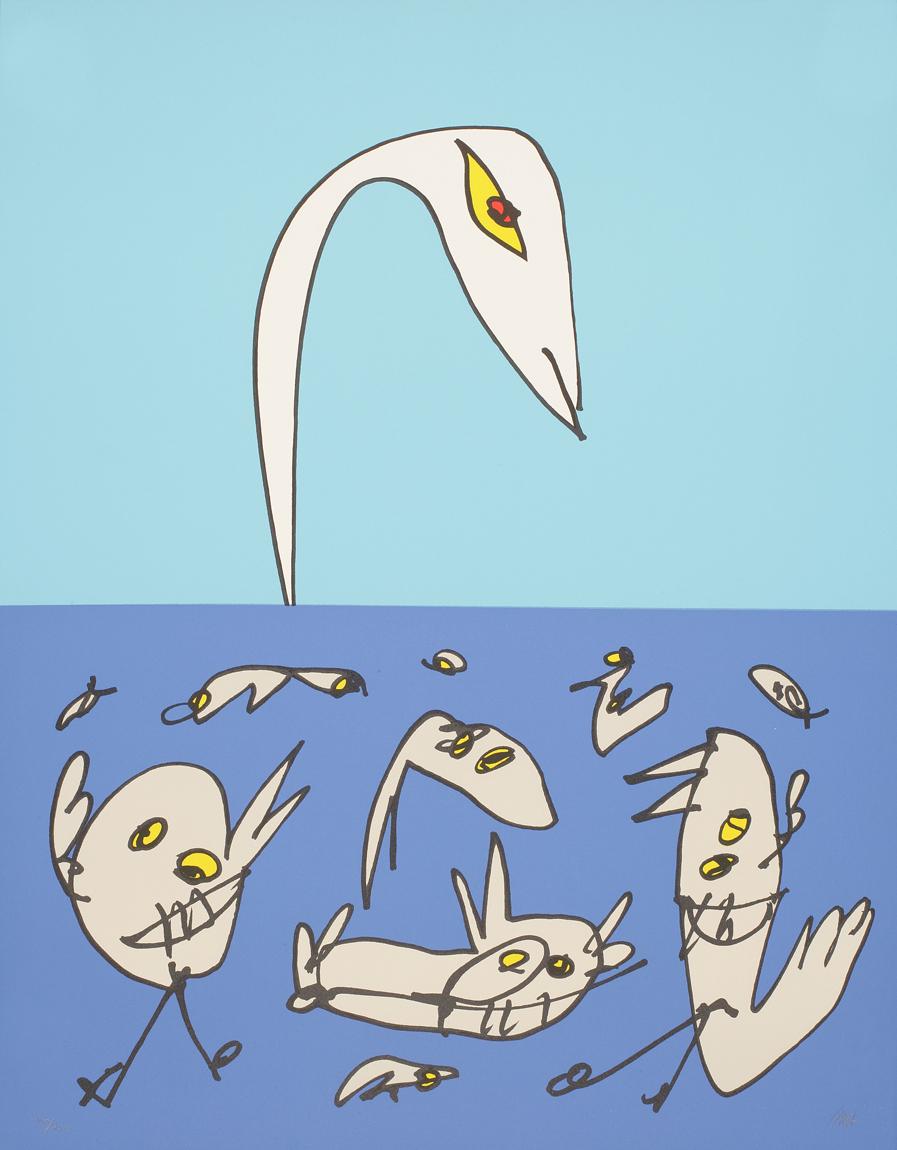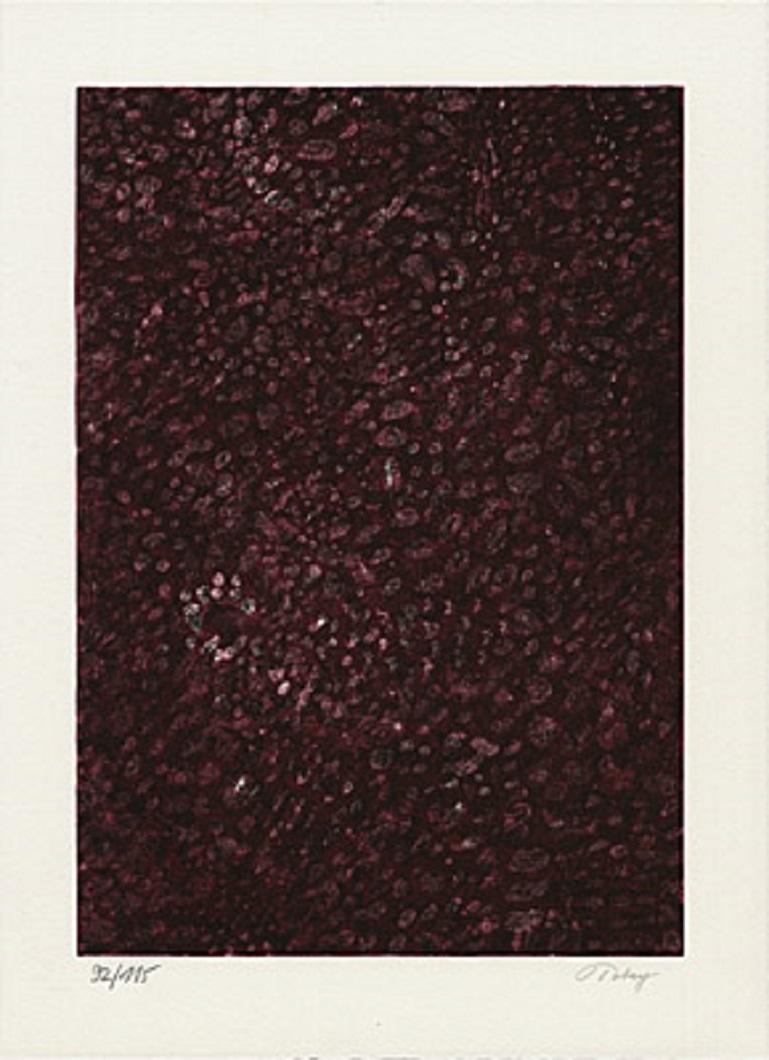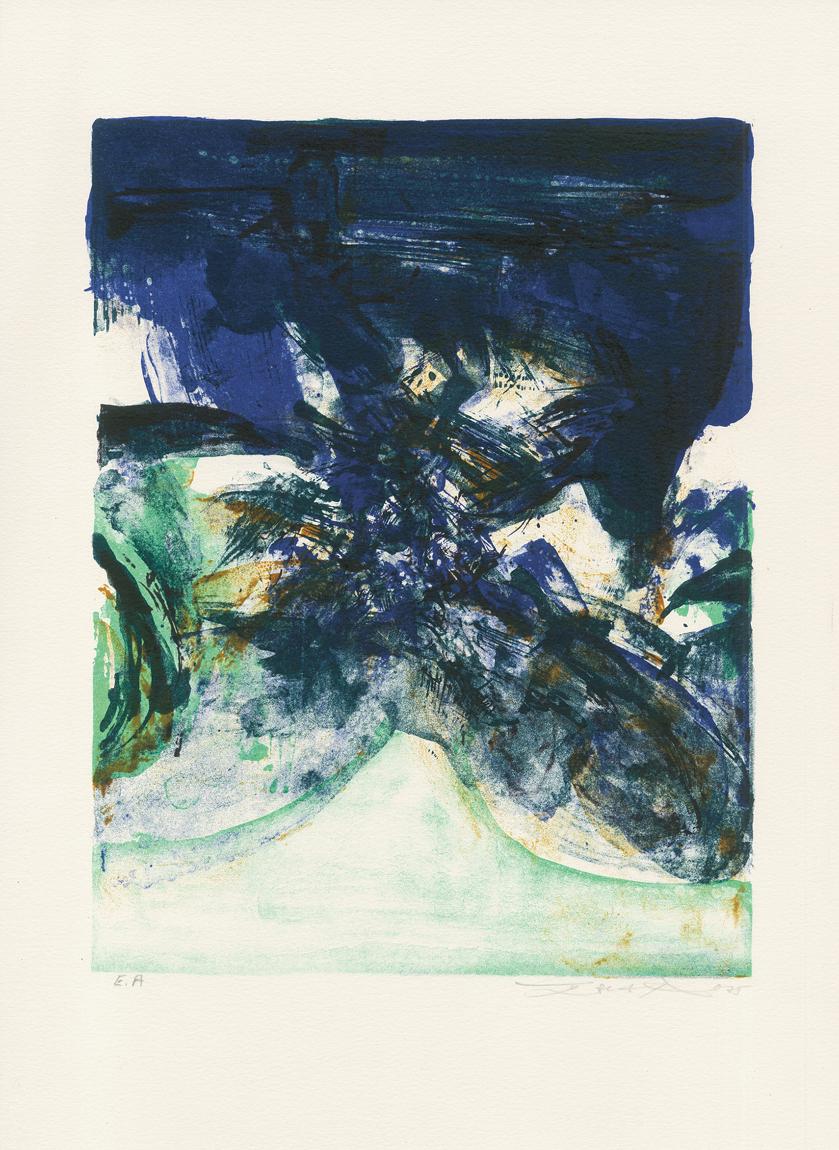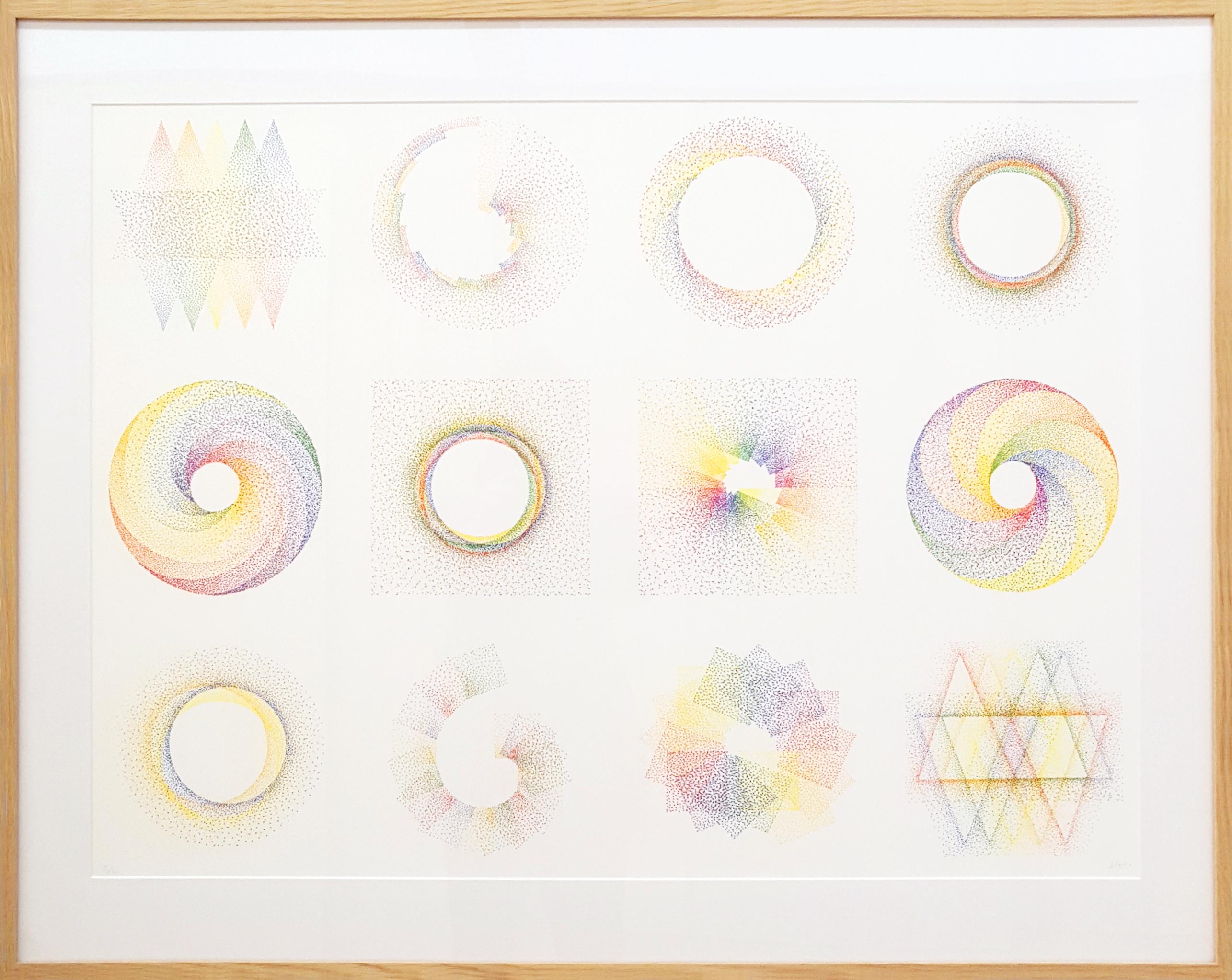Items Similar to Observador de Pajaros
Want more images or videos?
Request additional images or videos from the seller
1 of 8
Rufino TamayoObservador de Pajaros1950
1950
About the Item
"Observador de Pajaros" 1950
By. Rufino Tamayo (Mexican, 1899-1991)
Edition 83/210 Lower Right
Signed Lower Left
Unframed: 15.5" x 22.5"
Framed: 21.75" x 28.25"
Rufino Tamayo (August 26, 1899- June 24, 1991)
A native of Oaxaca in Southern Mexico, Rufino Tamayo's father was a shoemaker, and his mother a seamstress. Some accounts state that he was descended from Zapotec Indians, but he was actually 'mestizo' - of mixed indigenous/European ancestry. (Santa Barbara Museum of Art). He began painting at age 11. Orphaned at the age of 12, Tamayo moved to Mexico City, where he was raised by his maternal aunt who owned a wholesale fruit business.
In 1917, he entered the San Carlos Academy of Fine Arts, but left soon after to pursue independent study. Four years later, Tamayo was appointed the head designer of the department of ethnographic drawings at the National Museum of Archaeology in Mexico City. There he was surrounded by pre-Colombian objects, an aesthetic inspiration that would play a pivotal role in his life. In his own work, Tamayo integrated the forms and tones of pre-Columbian ceramics into his early still lives and portraits of Mexican men and women.
In the early 1920s he also taught art classes in Mexico City's public schools. Despite his involvement in Mexican history, he did not subscribe to the idea of art as nationalistic propaganda. Modern Mexican art at that time was dominated by 'The Three Great Ones' : Diego Rivera, Jose Clemente Orozco, and David Alfaro Siqueros, but Tamayo began to be noted as someone 'new' and different' for his blending of the aesthetics of post Revolutionary Mexico with the vanguard artists of Europe and the United States.
After the Mexican Revolution, he focused on creating his own identity in his work, expressing what he thought was the traditional Mexico, and refusing to follow the political trends of his contemporary artists. This caused some to see him as a 'traitor' to the political cause, and he felt it difficult to freely express himself in his art. As a result, he decided to leave Mexico in 1926 and move to New York, along with his friend, the composer Carlos Chavez. The first exhibition of Tamayo's work in the United States was held at the Weyhe Gallery, New York, in that same year. The show was successful, and Tamayo was praised for his 'authentic' status as a Mexican of 'indigenous heritage', and for his internationally appealing Modernist aesthetic. (Santa Barbara Museum of Art).
Throughout the late thirties and early forties New York's Valentine Gallery gave him shows. For nine years, beginning in 1938, he taught at the Dalton School in New York.
In 1929, some health problems led him to return to Mexico for treatment. While there he took a series of teaching jobs. During this period he became romantically involved with the artist Maria Izquierdo, with whom he lived and worked for several years. In 1933 he completed his first successful mural commission, a series of wall paintings for the Escuela Nacional de Musica (National School of Music). While working on this project, he met Olga Flores Rivas, a piano student at the school. Soon he separated from Izquierdo, and began a romance with Olga. The two were married in 1934. Although Olga was talented and had a budding performance career, she abandoned her musical pursuits to devote herself to promoting Tamayo's work. She was a lifelong muse to the artist, and over his seventy year career, he drew and painted many portraits of her.
They moved to New York in 1937, and he began to exhibit his work internationally. From 1937 to 1949, Tamayo and Olga lived there, and he became widely recognized for his signature form of abstract figuration. Some of his most valuable works were created during that time.
In 1943 Tamayo painted his first mural in the United States at the Hillyer Art Library at Smith College. Vogue magazine's 1946 issue referred to him as 'the best of young painters'. Look magazine also named him 'a fixed star in the New York art world'. (Santa Barbara Museum of Art) He was an elegant and media-savvy man, often photographed in his Upper East Side studio, with its wall of windows facing out onto Manhattan's fashionable townhouses.
The 1940s were however not without problems for the couple. Olga suffered from health problems, leading to several miscarriages, and the marriage was strained. Tamayo dedicated his work to her by adding an extra 'O' to his signature.
His fame was growing in Mexico. In 1948 his first major retrospective was held at the Palacio de Bellas Artes in Mexico City, and while he was still controversial, his popularity was high. He enjoyed broad commercial and critical success, but remained uncomfortable with the political differences and controversy, and so Tamayo and Olga moved to Paris in 1949. There he was welcomed by the artists and intellectuals of Europe. The French government named him Chevalier and Officier de la Légion d'Honneur in 1956 and 1969, respectively, and he was the recipient of numerous other honors and awards. Tamayo was among the first Mexican artists to be included in the Venice Biennale. He remained in Paris for 10 years, after which the couple returned permanently to Mexico.
His work was exhibited internationally in group and solo shows. Important Tamayo retrospectives took place at the São Paulo Bienal in 1977 and the Solomon R. Guggenheim Museum, New York, in 1979.
From 1933 to 1980, Tamayo painted 21 murals for an array of universities, libraries, museums, civic and corporate clients, hotels and an ocean liner. He was also an influential printmaker, and, in the latter part of his life embarked on the creation of sculpture. Tamayo eschewed the highly politicized themes explored within the works of his peers, and favored lyrical imagery and incorporated elements of Cubism, Surrealism and Expressionism. Mexican folklore and his Indian origins provided a constant source of inspiration for him.
Through his 70s and 80s he continued to be a prolific artist, teacher, and collector. Critics have extolled his bold and saturated use of color as his most significant contribution to Modern art. He was elected an honorary member of the American Academy and National Institute of Arts and Letters in 1961.
Rufino and Olga Tamayo donated the Museum of Pre-Hispanic Mexican Art to their native State of Oaxaca in 1974. Their personal holdings of more than 1,000 pieces of ceramics and sculpture formed the cornerstone of the collection. The Rufino Tamayo Museum of International Contemporary Art opened in Mexico in 1981, and it displays many of the artist's works, as well as paintings, sculpture and drawings from his private collection. At the time, it was the first major museum not run by the Government.
An interesting sidelight regarding Tamayo's work has to do with a theft. Tamayo's 1970 painting 'Tres Personajes' was bought by a Texan as a gift for his wife in 1977, then stolen from their storage locker during a move in 1987. In 2003, a woman, Elizabeth Gibson, found the painting in the trash on a New York City curb. She knew little about modern art, but felt the painting "had power" and took it without knowing its origin or market value. She spent four years trying to learn about the work, eventually learning it had been featured on an episode of Antiques Roadshow. Ultimately, Gibson and the former owner arranged to sell the painting at a Sotheby's auction. In November, 2007 Gibson received a $15,000 reward plus a portion of the $1,049,000 auction sales price.
Tamayo painted his last painting in 1989, at the age of 90, 'Hombre Con Flor' (Man withFlower), a self-portrait. Rufino Tamayo died in 1991 at the age of 92 in Mexico City. Olga passed away two and a half years later.
- Creator:Rufino Tamayo (1899-1991, Mexican)
- Creation Year:1950
- Dimensions:Height: 15.5 in (39.37 cm)Width: 22.5 in (57.15 cm)
- Medium:
- Movement & Style:
- Period:
- Condition:
- Gallery Location:Missouri, MO
- Reference Number:1stDibs: LU747310679552
About the Seller
5.0
Vetted Seller
These experienced sellers undergo a comprehensive evaluation by our team of in-house experts.
Established in 1970
1stDibs seller since 2017
141 sales on 1stDibs
Typical response time: 21 hours
- ShippingRetrieving quote...Ships From: Missouri, MO
- Return PolicyA return for this item may be initiated within 2 days of delivery.
More From This SellerView All
- Red and Blue SpiralsBy Alexander CalderLocated in Missouri, MORed and Blue Spirals Alexander Calder (American, 1898-1976) Signed in Pencil Lower Right Numbered 59/150 in Pencil Lower Left 26 x 37 inches 35.5 x 46 inches with frame One of Amer...Category
1970s Abstract Abstract Prints
MaterialsColor, Lithograph
- Blue Rings (Abstract Composition)By Yaacov AgamLocated in Missouri, MOBlue Rings (Abstract Composition), Serigraph By Yaacov Agam (Israeli, b. 1928) Signed Lower Right Edition 8/270 Lower Left Unframed: 21" x 21.5" Framed: 31" ...Category
20th Century Abstract Abstract Prints
MaterialsLithograph
- CurtainBy Yaacov AgamLocated in Missouri, MOCurtain By. Yaacov Agam (Israeli, b. 1928) Signed Lower Right Edition 221/227 Unframed: 18" x 22.5" Framed: 30.5" x 34.5" Yaacov Agam is one of the pioneer creators of the kinetic movement in art as well as its most outstanding contemporary representative. Agam was born in 1928 a son of a Rabbi of Rishon LeZion (Israel), who devoted his life to the study of Jewish religious matters and wrote books. Agam considers himself somehow as a visual continuation of his father's quest for spirituality. He studied at the Bezalel Academy of Art in Jerusalem, and in Switzerland at the Eidgenossische Technische Hochschule and the Zurich University. After arriving to Paris in 1951, Agam held his first one man exhibition with a great success in 1953 This exhibition consisted totally of kinetic, movable and transformable paintings, which actually was the first one-man show in art history exclusively devoted to kinetic art. A passionate experimenter, Agam deals with such problems as the 4th dimension, simultaneity and time in the visual, plastic arts, and has extended his experiments to application in the fields of literature, music and art theory. His works express a concept that breaks away with the established way of expressing reality in limited, static way. In his works, he strives to demonstrate the principle of reality as a continuous "becoming" rather than static "graven image." His paintings Double Metamorphosis 11 in the Museum of Modern Art in New York and Transparent Rhythms 11 in the Hirshhorn Museum and Sculpture Garden of the Smithsonian Institution in Washington, D.C. give the best example of his polymorphic painting. His works are placed in many public places including Communication x 9 on the Michigan Avenue in Chicago (1983), Communication: Night and Day at the AT&T building in New York (1974), Super Lines Volumes at the Pare Floral in Paris (1971), and his murals Peace and Life arc installed at the Parliament of Europe in Strasbourg (1977). Agam has expressed the new concepts in monumental works as in his Jacob's Ladder, which forms the ceiling of the National Convention House in Jerusalem. He created a "floating museum", including all the artworks for public areas and cabins, for the Carnival Cruise Line's luxury cruise ship "Celebration" (1987). His fire-water fountain in Dizengoff Square in Tel Aviv (1986) streams water, fire, and music -elements of flux and life which cannot be static - as its colored elements rotate in this multidimensional monumental work. For the Elysee Palace in Paris, with the request of President Georges Pompidou Agam created in 1972 a whole environmental of the Salon with the walls covered with polymorphic murals of changing images a kinetic ceiling, moving transparent colored doors and a kinetic carpet on which he placed a sculpture. It embraces viewers: they are no longer looking at a framed, fixed scene, but rather arc moving within an artistic space which changes constantly according to their shifting position and point of view. Similar attempt was made for the concert hall, Forum Leverkusen in Germany in 1970. Agam created many environmental sculptures, including Hundred Gates in the garden of the residence of the President of Israel in Jerusalem, 3 x 3 Interplay installed at the Julliard School of Music at the Lincoln Center and Wings of the Heart at J. F. Kennedy airport in New York. In 1984, he made a sculpture Beating Heart for the Hadassah Hospital in Jerusalem. In 1988, he created a transparent torah ark...Category
20th Century Abstract Abstract Prints
MaterialsLithograph
- EmergingBy Yaacov AgamLocated in Missouri, MOEmerging, 1985 By. Yaacov Agam ( Israeli, b. 1928) Color Serigraph Signed Lower Right Edition 1/12 Lower Left Unframed: 25" x 31" Framed: 34" x 43" Yaacov Agam is one of the pioneer creators of the kinetic movement in art as well as its most outstanding contemporary representative. Agam was born in 1928 a son of a Rabbi of Rishon LeZion (Israel), who devoted his life to the study of Jewish religious matters and wrote books. Agam considers himself somehow as a visual continuation of his father's quest for spirituality. He studied at the Bezalel Academy of Art in Jerusalem, and in Switzerland at the Eidgenossische Technische Hochschule and the Zurich University. After arriving to Paris in 1951, Agam held his first one man exhibition with a great success in 1953 This exhibition consisted totally of kinetic, movable and transformable paintings, which actually was the first one-man show in art history exclusively devoted to kinetic art. A passionate experimenter, Agam deals with such problems as the 4th dimension, simultaneity and time in the visual, plastic arts, and has extended his experiments to application in the fields of literature, music and art theory. His works express a concept that breaks away with the established way of expressing reality in limited, static way. In his works, he strives to demonstrate the principle of reality as a continuous "becoming" rather than static "graven image." His paintings Double Metamorphosis 11 in the Museum of Modern Art in New York and Transparent Rhythms 11 in the Hirshhorn Museum and Sculpture Garden of the Smithsonian Institution in Washington, D.C. give the best example of his polymorphic painting. His works are placed in many public places including Communication x 9 on the Michigan Avenue in Chicago (1983), Communication: Night and Day at the AT&T building in New York (1974), Super Lines Volumes at the Pare Floral in Paris (1971), and his murals Peace and Life arc installed at the Parliament of Europe in Strasbourg (1977). Agam has expressed the new concepts in monumental works as in his Jacob's Ladder, which forms the ceiling of the National Convention House in Jerusalem. He created a "floating museum", including all the artworks for public areas and cabins, for the Carnival Cruise Line's luxury cruise ship "Celebration" (1987). His fire-water fountain in Dizengoff Square in Tel Aviv (1986) streams water, fire, and music -elements of flux and life which cannot be static - as its colored elements rotate in this multidimensional monumental work. For the Elysee Palace in Paris, with the request of President Georges Pompidou Agam created in 1972 a whole environmental of the Salon with the walls covered with polymorphic murals of changing images a kinetic ceiling, moving transparent colored doors and a kinetic carpet on which he placed a sculpture. It embraces viewers: they are no longer looking at a framed, fixed scene, but rather arc moving within an artistic space which changes constantly according to their shifting position and point of view. Similar attempt was made for the concert hall, Forum Leverkusen in Germany in 1970. Agam created many environmental sculptures, including Hundred Gates in the garden of the residence of the President of Israel in Jerusalem, 3 x 3 Interplay installed at the Julliard School of Music at the Lincoln Center and Wings of the Heart at J. F. Kennedy airport in New York. In 1984, he made a sculpture Beating Heart for the Hadassah Hospital in Jerusalem. In 1988, he created a transparent torah ark...Category
20th Century Abstract Abstract Prints
MaterialsLithograph
- Untitled, (Serigraph)By Yaacov AgamLocated in Missouri, MOUntitled (Serigraph) By Yaacov Agam (Israeli, b. 1928) Signed Lower Right Edition 56/180 Lower Left Unframed: 20" x 8" Framed: 26.25" x 14" Yaacov Agam is one of the pioneer creators of the kinetic movement in art as well as its most outstanding contemporary representative. Agam was born in 1928 a son of a Rabbi of Rishon LeZion (Israel), who devoted his life to the study of Jewish religious matters and wrote books. Agam considers himself somehow as a visual continuation of his father's quest for spirituality. He studied at the Bezalel Academy of Art in Jerusalem, and in Switzerland at the Eidgenossische Technische Hochschule and the Zurich University. After arriving to Paris in 1951, Agam held his first one man exhibition with a great success in 1953 This exhibition consisted totally of kinetic, movable and transformable paintings, which actually was the first one-man show in art history exclusively devoted to kinetic art. A passionate experimenter, Agam deals with such problems as the 4th dimension, simultaneity and time in the visual, plastic arts, and has extended his experiments to application in the fields of literature, music and art theory. His works express a concept that breaks away with the established way of expressing reality in limited, static way. In his works, he strives to demonstrate the principle of reality as a continuous "becoming" rather than static "graven image." His paintings Double Metamorphosis 11 in the Museum of Modern Art in New York and Transparent Rhythms 11 in the Hirshhorn Museum and Sculpture Garden of the Smithsonian Institution in Washington, D.C. give the best example of his polymorphic painting. His works are placed in many public places including Communication x 9 on the Michigan Avenue in Chicago (1983), Communication: Night and Day at the AT&T building in New York (1974), Super Lines Volumes at the Pare Floral in Paris (1971), and his murals Peace and Life arc installed at the Parliament of Europe in Strasbourg (1977). Agam has expressed the new concepts in monumental works as in his Jacob's Ladder, which forms the ceiling of the National Convention House in Jerusalem. He created a "floating museum", including all the artworks for public areas and cabins, for the Carnival Cruise Line's luxury cruise ship "Celebration" (1987). His fire-water fountain in Dizengoff Square in Tel Aviv (1986) streams water, fire, and music -elements of flux and life which cannot be static - as its colored elements rotate in this multidimensional monumental work. For the Elysee Palace in Paris, with the request of President Georges Pompidou Agam created in 1972 a whole environmental of the Salon with the walls covered with polymorphic murals of changing images a kinetic ceiling...Category
20th Century Abstract Abstract Prints
MaterialsLithograph
- SpectrumBy Yaacov AgamLocated in Missouri, MOSpectrum By. Yaacov Agam (Israeli, b. 1928) Signed Lower Right Edition 158/180 Lower Left Unframed: 27" x 33.5" Framed: 36.5" x 43" Yaacov Agam is one of the pioneer creators of the kinetic movement in art as well as its most outstanding contemporary representative. Agam was born in 1928 a son of a Rabbi of Rishon LeZion (Israel), who devoted his life to the study of Jewish religious matters and wrote books. Agam considers himself somehow as a visual continuation of his father's quest for spirituality. He studied at the Bezalel Academy of Art in Jerusalem, and in Switzerland at the Eidgenossische Technische Hochschule and the Zurich University. After arriving to Paris in 1951, Agam held his first one man exhibition with a great success in 1953 This exhibition consisted totally of kinetic, movable and transformable paintings, which actually was the first one-man show in art history exclusively devoted to kinetic art. A passionate experimenter, Agam deals with such problems as the 4th dimension, simultaneity and time in the visual, plastic arts, and has extended his experiments to application in the fields of literature, music and art theory. His works express a concept that breaks away with the established way of expressing reality in limited, static way. In his works, he strives to demonstrate the principle of reality as a continuous "becoming" rather than static "graven image." His paintings Double Metamorphosis 11 in the Museum of Modern Art in New York and Transparent Rhythms 11 in the Hirshhorn Museum and Sculpture Garden of the Smithsonian Institution in Washington, D.C. give the best example of his polymorphic painting. His works are placed in many public places including Communication x 9 on the Michigan Avenue in Chicago (1983), Communication: Night and Day at the AT&T building in New York (1974), Super Lines Volumes at the Pare Floral in Paris (1971), and his murals Peace and Life arc installed at the Parliament of Europe in Strasbourg (1977). Agam has expressed the new concepts in monumental works as in his Jacob's Ladder, which forms the ceiling of the National Convention House in Jerusalem. He created a "floating museum", including all the artworks for public areas and cabins, for the Carnival Cruise Line's luxury cruise ship "Celebration" (1987). His fire-water fountain in Dizengoff Square in Tel Aviv (1986) streams water, fire, and music -elements of flux and life which cannot be static - as its colored elements rotate in this multidimensional monumental work. For the Elysee Palace in Paris, with the request of President Georges Pompidou Agam created in 1972 a whole environmental of the Salon with the walls covered with polymorphic murals of changing images a kinetic ceiling, moving transparent colored doors and a kinetic carpet on which he placed a sculpture. It embraces viewers: they are no longer looking at a framed, fixed scene, but rather arc moving within an artistic space which changes constantly according to their shifting position and point of view. Similar attempt was made for the concert hall, Forum Leverkusen in Germany in 1970. Agam created many environmental sculptures, including Hundred Gates in the garden of the residence of the President of Israel in Jerusalem, 3 x 3 Interplay installed at the Julliard School of Music at the Lincoln Center and Wings of the Heart at J. F. Kennedy airport in New York. In 1984, he made a sculpture Beating Heart for the Hadassah Hospital in Jerusalem. In 1988, he created a transparent torah ark...Category
20th Century Abstract Abstract Prints
MaterialsLithograph
You May Also Like
- Untitled from "Vingt-deux poèmes" by Giuseppe Santomaso, Black, Blue, CassouBy Giuseppe SantomasoLocated in Köln, DEColor lithograph by Giuseppe Santomaso Untitled from "Vingt-deux-poèmes" (Portfolio with artworks by several artists and 22 poems by Jean Cassou. The work...Category
1970s Abstract Abstract Prints
MaterialsLithograph
- Cali - 20th Century, Maurice Estève, Abstract Print, Colourful, LithographBy Maurice EstèveLocated in Köln, DE"Cali" is a typical motif by Maurice Estève. The lithograph in colours was published in an edition of 100. 49,6 x 65 cm. Signed and numbered.Category
1960s Abstract Abstract Prints
MaterialsLithograph
- "El patito feo" by Antonio Saura, Abstract Print, Duckling, Blue, Bright ColorsBy Antonio SauraLocated in Köln, DEColor lithgraph by Antonio Saura "El patito feo", 1997 65 x 50 cm Copy 186/250 Edition of 285 Antonio Saura (Huesca, Spain 1930–1998 Cuenca) found his...Category
1990s Abstract Abstract Prints
MaterialsLithograph
- Untitled from "Vingt-deux poèmes" by Mark Tobey, Lithography, Cassou, Black, RedBy Mark TobeyLocated in Köln, DEColor lithograph by Mark Tobey (Centerville, Wisconsin 1890 - 1976 Basel) from "Vingt-deux poèmes" (Portfolio with artworks by several artists and 22 poems by Jean Cassou...Category
1960s Abstract Expressionist Abstract Prints
MaterialsLithograph
- Untitled from "San Lazarro et ses amis" by Zao Wou-Ki, Lithography, Blue, GreenBy Zao Wou-KiLocated in Köln, DEColor lithograph by Wou-Ki Zao Untitled from "San Lazarro et ses amis" (portfolio with texts by Yvon Taillandier), 1975 56,5 x 37 cm Copy e.a. Edition of 50 Zao Wou-Ki (Peking 19...Category
1970s Abstract Abstract Prints
MaterialsLithograph
- AlchimiesBy Julio Le ParcLocated in LILLE, FRSigned and numbered art print by Julio Le Parc including all the "ALCHIMIES" drawn for its artists book "Petite bifurcation de celui qui n'est pas" published by Editions Sylvain Cour...Category
2010s Abstract Geometric Abstract Prints
MaterialsLithograph
Recently Viewed
View AllMore Ways To Browse
Vintage Valentines Art
Vintage Valentine Art
Ocean Liner Art
Valentine Sculpture
Storage Lockers Used
Antique Valentine
Vintage French Valentine
Vintage French Valentines
Abstract Print 80s
Abstract Self Portrait Sculpture
De Rivera
70s Modernist Art
Piano Man
Piano Designer
80s Lithograph
Lithographs Marriage
Man And Woman Abstract Sculpture
June Felter
